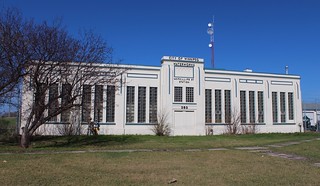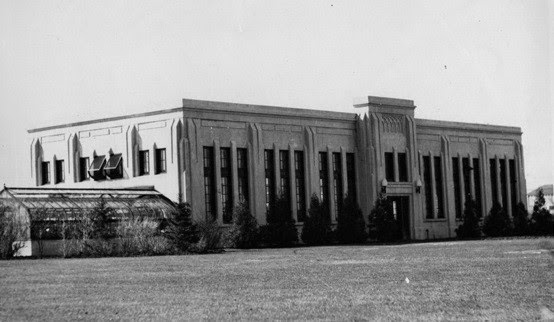Bottom: ca. 1930 Winnipeg Tribune Photo Collection, University of Manitoba Archives
My column in today's Winnipeg Free Press is about the McPhilllips Street Pumping StationNo. 2. next time you're driving by McPhillips Street and Logan Avenue, keep an eye out for it !
Below, I've included some newspaper clippings about the station and you can visit my Flickr photo album of a recent tour !
Under construction, May 23, 1929, Winnipeg Tribune

















5 comments:
I'd like to know if this has anything to do with a long-ago demolished structure at the NW corner of Keewatin and Selkirk, and if the McPhillips location replaced it in 1929/31.
In the Henderson Directories between 1913 and 1931 it was called City Well No. 5 and No. 5 City Pumping Station. There was no fixed address, and it was listed on both Keewatin or Selkirk. The 1931 directory added the term "closed" to the entry.
I think it was closed for decades, and was demolished at least 15 to 20 years ago. The structure was brown and resembled a miniature grain elevator and perhaps 2 stories. Now, at that corner, is a metal fenced empty plot with green grass and a few shrubs and trees.
City well number 5 and its pumping station (built in 1907) were part of Winnipeg's artesian well system that supplied water to the city prior to the opening of the Shoal Lake Aqueduct in 1919.
Winnipeg's long-time city engineer, Col. Henry N. Ruttan, thought that all Winnipeg's future water needs could be supplied by the aquifer that stretches many miles to the north and west and a string of wells, beginning in 1901 with Wells Number 1 and 2 at the McPhillips Street pumping station, were mostly dug north along McPhillips Street.
A downside of the artesian water was its hardness. To combat this the city created North America's first municipal water softening plant in 1901. No, not to keep Winnipeg's underclothes downy soft, but to keep industrial machinery from getting clogged by mineral deposits.
The existence of the aquifer was common knowledge long before Well Number 1. Many private wells existed in the city from its earliest settlement and in the early 1880s the city began digging public wells with pumps or standpipes for general use. The major complaint was that many of these wells froze up in the winter and the city did nothing to keep them operational. At the wells that did function water that slopped on the ground instantly froze into a skating rink to the hazard of anyone trying to pump.
Notwithstanding Col. Ruttan's optimism it soon became clear that the more holes that were punched in the lid of the aquifer the less productive each well became. In fact the drilling of the first well provoked an outcry from the city's watermen who claimed that the city well caused their private wells to dry up.
The city wells weren't artesian in the true sense since water didn't flow to the surface of the ground (a true artesian or flowing well existed on the property of the Bay Horse hotel, on the south side of Portage near Good street). However, the water rose high enough to make pumping easier.
The practicalities of operating an artesian well system had to be learned the hard way. When water blasted into the Well Number 1's initial pit it dislodged so much rock and dirt from the pit walls that the well became plugged. A hard-hat diver had to be sent to the bottom of the pit to shovel out the debris by hand. Subsequently a large diameter steel pipe was driven down to bedrock.
At each well water flowed up the pipe into a concrete caisson averaging 18 feet in diameter. As workers inside the caisson shoveled out the dirt, the caisson gradually sank down to bedrock aided by a steel sawtooth ring at its bottom edge.
Well Number 2, drilled beside Number 1, was a failure, proving that two wells drilled at the same spot did not double production. Number 2 was abandoned and subsequent wells were drilled a considerable distance from earlier wells.
Well work was hazardous. At least one excavator died of the bends and in 1908 two workers were found dead at well number 4. One seems to have fallen into the caisson and the other apparently succumbed to lack of oxygen while trying to rescue him.
Well Number 5 continued to be productive, pumping its water through a pipe along Selkirk Avenue into the city water system. Eventually it became obsolete and was sold to a private party in 1934:
"Sale Is Approved. Sale of the site of old artesian well No. 5, corner of Keewatin st. and Selkirk ave., Rosser municipality, to Edward Cook, 224 Higgins ave., for $300, was approved Monday night by the city council. This well was, in its day, a prolific source of the city's water supply, furnishing about 1,000,000 gallons a day. There is an old building on the site which is included in the price." (Tribune, Dec 18, 1934, p. 3).
Some of this information comes from David A Ennis's excellent illustrated Master's thesis online at U of M (Developing a Domestic Water Supply for Winnipeg from Shoal Lake and Lake of the Woods: The Greater Winnipeg Water District Aqueduct, 1905 – 1919)
Other info is from the Tribune via U of M's Digital Collections site and Henderson's Directories on the Peel's Prairie Provinces site.
Excellent reply from Mr.Beattie,
I can advise that in the mid 1990s the tiny wooden, 1 story gable roofed " shack" was finally removed from this location. It was nothing special, decrepit is a word that comes to mind.
Was probably removed due to vandals getting into the shed and causing grief to the neighborhood. As of May 2018, this parcel of land still has a 10 foot chain link fence around it and is for sale .
Anonymous thanks for your comment. Your description of the "shack" is how I remembered it. Too bad there aren't any pics about it, and for some reason I've never really found stories about that plot of land or the removal of the "shack."
Post a Comment